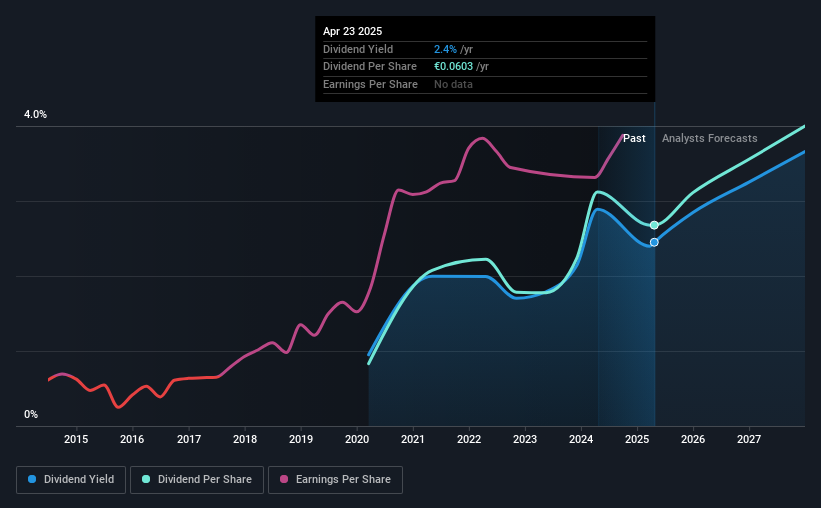- Greece
- /
- Personal Products
- /
- ATSE:PAP
Be Sure To Check Out Papoutsanis S.A. (ATH:PAP) Before It Goes Ex-Dividend

Papoutsanis S.A. (ATH:PAP) is about to trade ex-dividend in the next three days. The ex-dividend date is commonly two business days before the record date, which is the cut-off date for shareholders to be present on the company's books to be eligible for a dividend payment. The ex-dividend date is important as the process of settlement involves at least two full business days. So if you miss that date, you would not show up on the company's books on the record date. Accordingly, Papoutsanis investors that purchase the stock on or after the 28th of April will not receive the dividend, which will be paid on the 5th of May.
The company's next dividend payment will be €0.03 per share. Last year, in total, the company distributed €0.06 to shareholders. Looking at the last 12 months of distributions, Papoutsanis has a trailing yield of approximately 2.4% on its current stock price of €2.46. We love seeing companies pay a dividend, but it's also important to be sure that laying the golden eggs isn't going to kill our golden goose! We need to see whether the dividend is covered by earnings and if it's growing.
Our free stock report includes 3 warning signs investors should be aware of before investing in Papoutsanis. Read for free now.If a company pays out more in dividends than it earned, then the dividend might become unsustainable - hardly an ideal situation. Papoutsanis paid out just 0.04% of its profit last year, which we think is conservatively low and leaves plenty of margin for unexpected circumstances.
See our latest analysis for Papoutsanis
Click here to see how much of its profit Papoutsanis paid out over the last 12 months.

Have Earnings And Dividends Been Growing?
Businesses with strong growth prospects usually make the best dividend payers, because it's easier to grow dividends when earnings per share are improving. If earnings fall far enough, the company could be forced to cut its dividend. That's why it's comforting to see Papoutsanis's earnings have been skyrocketing, up 31% per annum for the past five years.
The main way most investors will assess a company's dividend prospects is by checking the historical rate of dividend growth. Since the start of our data, five years ago, Papoutsanis has lifted its dividend by approximately 26% a year on average. Both per-share earnings and dividends have both been growing rapidly in recent times, which is great to see.
Final Takeaway
From a dividend perspective, should investors buy or avoid Papoutsanis? Typically, companies that are growing rapidly and paying out a low fraction of earnings are keeping the profits for reinvestment in the business. This is one of the most attractive investment combinations under this analysis, as it can create substantial value for investors over the long run. Overall, Papoutsanis looks like a promising dividend stock in this analysis, and we think it would be worth investigating further.
In light of that, while Papoutsanis has an appealing dividend, it's worth knowing the risks involved with this stock. Case in point: We've spotted 3 warning signs for Papoutsanis you should be aware of.
A common investing mistake is buying the first interesting stock you see. Here you can find a full list of high-yield dividend stocks.
New: Manage All Your Stock Portfolios in One Place
We've created the ultimate portfolio companion for stock investors, and it's free.
• Connect an unlimited number of Portfolios and see your total in one currency
• Be alerted to new Warning Signs or Risks via email or mobile
• Track the Fair Value of your stocks
Have feedback on this article? Concerned about the content? Get in touch with us directly. Alternatively, email editorial-team (at) simplywallst.com.
This article by Simply Wall St is general in nature. We provide commentary based on historical data and analyst forecasts only using an unbiased methodology and our articles are not intended to be financial advice. It does not constitute a recommendation to buy or sell any stock, and does not take account of your objectives, or your financial situation. We aim to bring you long-term focused analysis driven by fundamental data. Note that our analysis may not factor in the latest price-sensitive company announcements or qualitative material. Simply Wall St has no position in any stocks mentioned.
About ATSE:PAP
Papoutsanis
Engages in the production and sale of soaps and liquid cosmetics in Greece.
Solid track record and good value.
Market Insights
Community Narratives


